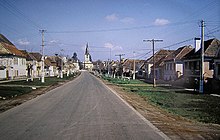Nocrich
|
Nocrich Leschkirch Újegyház |
||||
|
||||
| Basic data | ||||
|---|---|---|---|---|
| State : |
|
|||
| Historical region : | Transylvania | |||
| Circle : | Sibiu | |||
| Coordinates : | 45 ° 54 ' N , 24 ° 27' E | |||
| Time zone : | EET ( UTC +2) | |||
| Height : | 419 m | |||
| Area : | 112.59 km² | |||
| Residents : | 2,868 (October 20, 2011) | |||
| Population density : | 25 inhabitants per km² | |||
| Postal code : | 557165 | |||
| Telephone code : | (+40) 02 69 | |||
| License plate : | SB | |||
| Structure and administration (as of 2016) | ||||
| Community type : | local community | |||
| Structure : | Nocrich, Fofeldea , Ghijasa de Jos , Hosman , Țichindeal | |||
| Mayor : | Ionel Vișa ( PNL ) | |||
| Postal address : | Str. Principală, no. 274 loc. Nocrich, jud. Sibiu, RO-557165 |
|||
| Website : | ||||
Nocrich ( German Leschkirch , Hungarian Újegyház ) is a municipality in the Sibiu district in Transylvania , Romania .
location
Nocrich is located in the Harbachtal on the district road ( drum județean ) DJ 106 and on a narrow-gauge railway that connects the 32 kilometers away district capital Sibiu ( Hermannstadt ) and the city Agnita ( Agnetheln ) 28 kilometers away . On the Wusch , as the train is affectionately known, the traffic rests.
The municipality of Nocrich includes the five localities: Nocrich, Fofeldea ( high field ), Ghijasa de Jos ( lower bottom ) , Hosman ( quantities of wood ) and Țichindeal ( Ziegenthal ).
population
In the entire municipality of Nocrich in 2002, 2,430 of the 2,641 inhabitants at that time described themselves as Romanians , 195 as Roma , eight as Hungarians and seven as Germans . The highest number of Romanian Germans (1,382) was counted on the territory of the municipality in 1941. In 2002, a total of 1,174 people lived in the village of Nocrich, of which 1,116 were Romanians, three Roma, three Hungarians, one German and one Lipovan .
Attractions
- Evangelical fortified church Nocrich , a medieval fortification, of which four bastions and a defensive wall have been preserved. The focus was on a Romanesque basilica from the 13th century, which was demolished on the instructions of Samuel von Brukenthals in order to build a new church on its property from 1803 to 1806.
- Evangelical rectory , it was built from 1796 to 1798 and is preserved as a historical monument.
- Orthodox Church of St. Vasile , it is located in the village of Fofeldea, which belongs to Nocrich. It was restored between 1975 and 1978. The interior painting comes from the Grecu brothers from Săsăuș
- Evangelical fortified church wood , which was built in the 13th century. In the 18th century it was converted into a baroque hall church. The original castle consisted of two curtain walls and six towers. In 1993 the fortified church was restored. (More on this in the special article on Hosman .)
- Orthodox Church of Venerable Paraschiva in Țichindeal , It was built in 1791 and has been preserved as a historical monument. The interior painting is also here by the Grecu brothers.
Pictures of the Evangelical Church in Nocrich
Personalities
- Samuel von Brukenthal (1721–1803), governor of Transylvania
- Franz Conrad (1797–1846), politician, diplomat, court agent of the royal Transylvanian court chancellery in Vienna, authorized representative of the Saxon nation
- August Treboniu Laurian (1810–1881), historian and publicist, came from Fofeldea
- Samuel Dörr (1824–1911), member of the Hungarian Diet
- Carl Eduard Conrad (1830–1906), politician, member of the Royal Hungarian Diet in Budapest, royal notary in Kronstadt / Brașov
- Gustav Adolph Conrad (1841–1903), forest scientist, natural and local historian and founder of Transylvanian forest science
Web links
Individual evidence
- ↑ 2011 census in Romania at citypopulation.de
- ^ Censuses in Transylvania 1850-2002 (Hungarian; PDF; 582 kB).
- ↑ August Treboniu Lauarian in the Lexicon of the Revolutions of 1848 (English)







